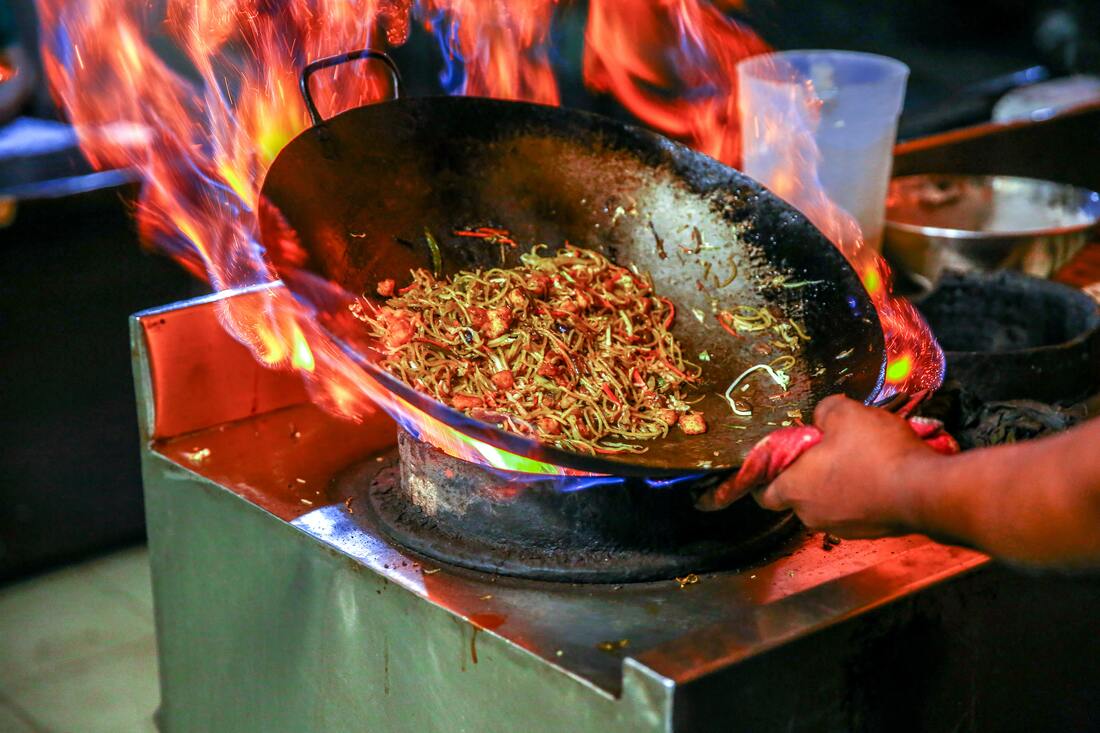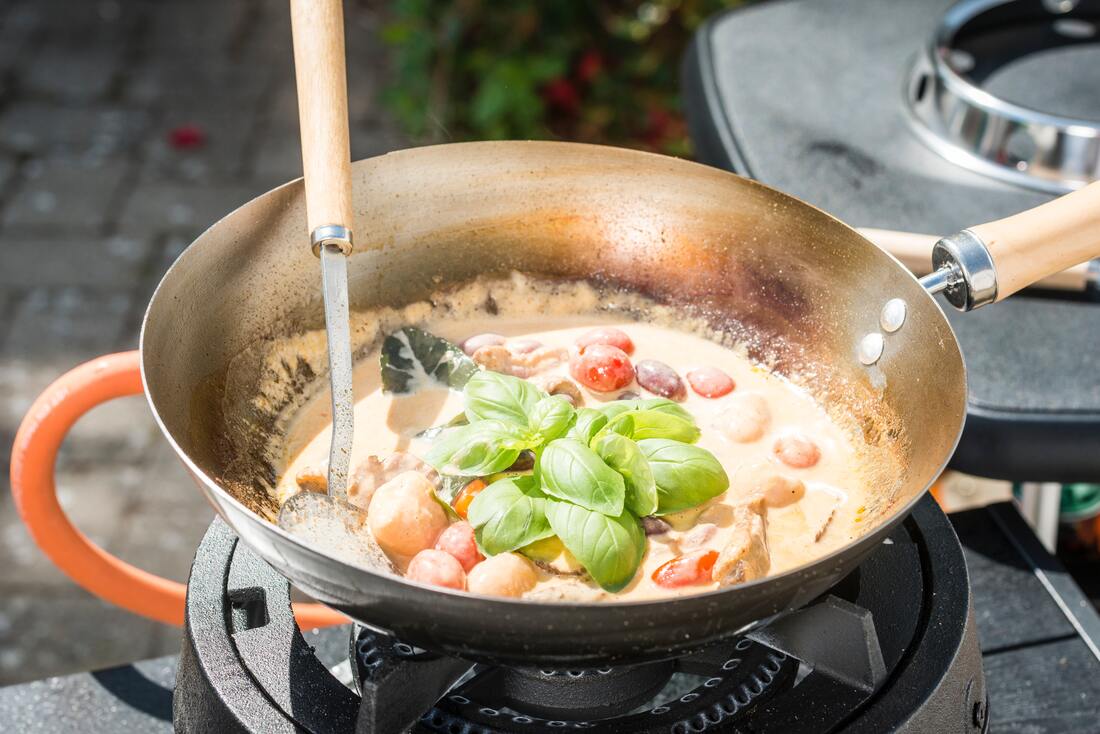|
Buying a wok The wok is the most versatile and handy tool in the kitchen and a good cast iron wok, the basis of all Chinese cooking. A good cast-iron wok, when handled properly, will be your companion for years to come and your relationship with it will only get better and stronger with time ;) We've all heard of "wok-hei" or the breath of the wok - it's that special kiss of flavor your cast-iron wok imparts to your recipe. So, if you want your fried rice and Chinese stir-fries to taste like your favorite Chinese restaurant, then forget your regular pans, head over to Chinatown and invest in a good cast-iron wok. Size - Woks come in several sizes, so pick one that is best suited to your own needs - depending on your stove size and the number of people you'd be cooking for. Personally, I prefer not to cook for more than 4 people at a time in my large wok. This is to ensure that there is enough surface area on the wok for the ingredients to comfortably mingle with each other and be in contact with the surface of the wok. Handles - Some woks come with metal handles and therefore rely on the use of a tea-towel to keep them in place (like the one above); these are great for seasoned Chinese chefs to put on a show. Others come with comfortable wooden handles and work perfectly for home-cooks (like the one below). How to clean a wok for the first time? New woks are generally covered in nasty factory oils to keep them from going rusty during shipping and storage. Before you season your wok, it is important to remove all the nasties and the dust it may have collected over time; this is probably the only time you will thoroughly clean your wok using a heavy-duty scrub. Follow the steps below to get your wok squeaky clean, 1. Clean your wok inside out with dish soap, hot water and a heavy duty scrub, until squeaky clean. Rinse well, then wipe it dry with kitchen towels. 2. Place your wok on your stove top and switch on the flame on medium-high heat. Let the wok heat up and dry completely. Your wok is now ready to be seasoned. How to season a wok? These may look like a lot of steps but they are really easy to follow.
STEP 1: Removing Excess Residue 1. Place your wok on a stove-top on medium-high heat. Pour a tablespoon of vegetable oil into the wok (any oil with a high smoking point will work). Using a few layers of folded kitchen-towel, spread the oil all over the inside of the wok. Be careful not to burn your fingers while doing so. 2. Continue to heat the wok until the oil reaches its smoking point. Keep your exhaust going and windows open while doing so, as it will get smoky at this stage. 3. Reduce heat to low and move the oil around the inside of the wok. The oil will start to thicken and change to a darker color at this point. 4. Rinse the wok with soap and hot water to get rid of the dark residue. Dry with paper towels and proceed with STEP 2. STEP 2: First Layer of Seasoning 1. Place your clean wok on medium flame and let it heat up. 2. Add a tablespoon of vegetable oil and swirl it all around the inside of the wok. 3. Continue to heat the pan for 10 minutes, changing it position and exposing different parts of the pan to direct heat. Keep you exhaust on and windows open. 4. You will see more dark residue toward the end but this time slightly clearer than it was before. 5. Rinse the wok with soap and hot water again to get rid of the unwanted residue. Dry with paper towels and proceed with STEP 3. STEP 3: Stain Removal 1. Heat up your wok again and scrape away any burnt bits using a metal spatula. To remove any stains on the bottom of the wok, pour a bowl-full of water and bring to the boil. Discard the water, and clean the wok again with soap and hot water. Dry with paper towels. Proceed with step 4. STEP 4: Second Layer of Seasoning 1. This step is similar to STEP 2. Place your clean wok on medium flame and let it heat up. 2. Add a tablespoon of vegetable oil and swirl it all around the inside of the wok. Using a well folded kitchen towel, rub the oil well into the surface of the wok. Be careful not to burn your fingers. And, remember to keep your exhaust on and windows open. 3. Continue to heat the pan for 10 minutes, changing it position and exposing different parts of the pan to direct heat. This time the oil should be clear, with no dark residue in it. 4. Rinse the wok with soap and hot water again. Dry with paper towels and proceed with STEP 5. STEP 5: Final Coating and Storage 1. Your wok should now look clean and smooth. It's time to apply the final coating and this time all over the inside and outside of the pan, to keep it from going rusty during storage. 2. Pre-heat your wok on medium flame until smoking. Pour a tablespoon of vegetable oil; using a paper towel rub oil all over on the inside of the wok. Set aside to cool and rub some oil all over the outside of the wok too. Your wok is now ready to stored away. Repeat step 5 each time after using and washing your wok. Cooking in your cast-iron wok creates a "patina", a protective coating on the inside of the pan. Every time you cook with oil in your wok, the patina becomes thicker and heavier closing the pores and creating a natural, non-stick surface. This protective layer also prevents rust and corrosion caused due to humidity. and enhances the flavor of your dishes. The more you use your wok, the more you enhance the patina :) Wok Cooking Tips
Invest in a good cast iron wok if you do any amount of Chinese cooking. Woks are practically indestructible - a good wok will last you for years to come. Happy woking!
0 Comments
|
AuthorPayal Thakurani is a cooking instructor, consulting chef, and author of the popular Southeast Asian cookbook “Curries for the Soul”. Originally based in Shanghai China, chef Payal has been in the food industry since 2012, working in training and brand development in central kitchens. She was also the proud owner of a cooking school and several food brands in Shanghai. She now lives in Singapore and heads Commune Kitchen in Downtown Gallery, where she hosts affordable, hands-on cooking classes for all ages. ArchivesCategories |
ServicesAs Listed On:
|
OUR KITCHENCommune Kitchen Pte. Ltd
182 Cecil Street #02-10/11 Frasers Tower 069547 |
|
© COPYRIGHT 2023. ALL RIGHTS RESERVED.



 RSS Feed
RSS Feed
